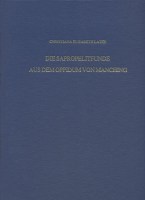Search
Die Sapropelitfunde aus dem Oppidum von Manching
2014
22.5 x 31.0 cm, 256 p., 2 illustrations color, 219 illustrations b/w, 8 tables b/w, 8 Tabellen, 16 Tafeln, cloth
ISBN: 9783954900732
22.5 x 31.0 cm, 256 p., 2 illustrations color, 219 illustrations b/w, 8 tables b/w, 8 Tabellen, 16 Tafeln, cloth
68,00 €
ISBN: 9783954900732
Short Description
The oppidum of Manching yielded one of the largest collections of objects made of sapropelite and related dark rocks in Europe dating to the La Tène period. Especially due to scientific analysis, this find category offers major insights into the economic and cultural relations of Manching during its early stages. Also, the finds are discussed regarding their chronological significance for dating the beginnings of the Manching settlement.The book presents an up-to-date overview of research history and current research into this material and deals with questions of chronology, jewellery, economy and the symbolic meaning of artefacts made of dark stones during the late Iron Age of Continental Europe.
Description
Objects made of sapropelite and related rocks of fossile origin, mainly bracelets, are a common part of the material culture in Iron Age Europe. Nevertheless, they often play a minor role in archaeological studies. However, especially by scientific analysis, partly able to determine the provenience of the raw material, it is possible to contribute to questions of cultural and economic relations.The excavations in the oppidum of Manching in Southern Bavaria yielded one of the largest collections of objects made of sapropelite and similar materials dating to the La Tène period. In addition, more samples were submitted to palynological and petrographic analysis than from any other site of the Late Iron Age, providing a solid basis for further research.
The study outlines different questions connected to the raw material as well as typological issues and discusses the significance of sapropelite finds for dating the beginnings of the Manching settlement. Furthermore, it focuses on their relevance for the reconstruction of trade and communication networks, which involved Manching and the surrounding La Tène culture of Southern Bavaria.
For this purpose, the richly illustrated study does not centre on Manching alone, but presents an up-to-date overview of research history and current perspectives as well as of many more issues concerning objects made of sapropelite and related raw materials; burial and settlement finds from the whole area of the La Tène culture in Continental Europe, from the Atlantic coast to the Carpathian Basin, are included. They are analysed regarding issues of chronology, jewellery, economy and the symbolic meaning of artefacts made of dark stones. Due to this comprehensive approach, it is possible to identify regional trends and specificities in the use of these artefacts, which represent important building blocks for reconstructing contact areas during the Late Iron Age, not only for Manching.
This find category allows insights into regionally and chronologically differing distribution patterns and the transfer of goods covering partly long distances, but also into the immaterial exchange of knowledge and ideas throughout the European La Tène culture. At the same time, the objects made of sapropelite and related materials reflect the importance of the Manching region as an economic centre already as early as the 3rd century BC. Thus, this insignificant group of artefacts illuminates the complex network, into which the settlement of Manching was imbedded from its beginning and which provided the framework for Manching’s further development towards an oppidum in the late La Tène period.




 Preface
Preface

 Neuerscheinungen 2023/2024
Neuerscheinungen 2023/2024
 Gesamtverzeichnis 2023/2024
Gesamtverzeichnis 2023/2024
 Katalog Oriental Studies & Linguistics
Katalog Oriental Studies & Linguistics
 Mittelalter
Mittelalter
 Deutsche Inschriften
Deutsche Inschriften
 Musiktherapie
Musiktherapie
 Literaturen im Kontext
Literaturen im Kontext